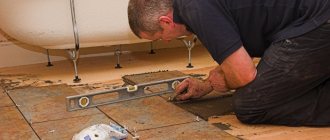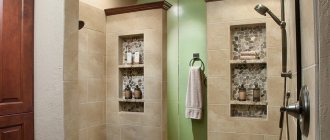Comfort in the bathroom is ensured not only by plumbing fixtures or household appliances, but also by useful little things, including grab bars for bathrooms. Such an accessory can be of great benefit, especially if there are people in the house with disabilities, elderly people or pregnant women. It is no secret that hygiene procedures in some situations turn into a difficult and even dangerous undertaking. The handrail will protect you from slipping and falling on a slippery floor, which means from serious injuries or even worse consequences.
Bath grab bar
What types of bath handles are there to make getting up comfortable?
When arranging a home in which a person with limited activity plans to live, it is necessary to equip premises for special purposes. Among these are places of daily use: the bathroom and sanitary unit. These rooms require a large number of different support mechanisms.
You can get acquainted with the options for handles for a bathroom designed for people with disabilities in specialized stores
Today, handrails for people with limited mobility are divided into:
- Stationary - supporting structures that are fixed at both ends (most often to the wall and floor), are characterized by stability, strength and long service life (due to the absence of a moving element, which often wears out quickly). It is convenient to use such systems for the reason that they always remain “disassembled” when the folding handles need to be brought into the required position (often older people forget that the handle is folded, and this can lead to loss of balance). It is better to install stationary supports in spacious bathrooms: this way they will not interfere with the movement of all family members.
- Folding systems are systems that are mounted to the wall on one side, remain movable and save space in the room. There are modifications of the folding design with turns left and right, up and down. Folding grab bars are often installed next to the toilet, sink, or shower.
- Mobile. These designs include portable handles with a vacuum fastening system.
At the same time, handles come in different sizes and diameters, with different angles of inclination. Depending on the scope of application, handrails are divided into straight and angular for bathtubs and showers, sinks (rectangular, square or curved); overhead on the side of the bathroom; folding ones in the bathroom.
Possible mistakes
The most important thing is the correct installation of handrails to avoid injury to the patient.
There is a special legal act that specifies all the requirements for equipment so that a disabled person is provided with unhindered access to premises for any purpose. An error during installation will pose a risk of injury, so saving on it in this case is inappropriate. When choosing a design, be sure to consult with a specialist.
The degree of importance of compliance with all rules becomes higher if adaptations for disabled people in the toilet and bathroom are installed in a medical institution, where a special expert commission must be present when the facility is handed over. If inconsistencies are found, the building will not be put into operation.
If you are confident in your abilities and install handrails for home use, do not forget to focus on the individual characteristics of the person - height, build and weight. Since due to some diseases the motor skills of the limbs are impaired (after paralysis, stroke or Parkinson’s disease), do not make mistakes and when installing, focus on your working hand.
Another common mistake is neglecting the materials used. The best option is to use chrome coatings to prevent slipping. Many people do not pay attention to the fact that handrails for bathtubs must be rubberized or have a special thread.
Remember that using a bathroom for people with disabilities should be safe and comfortable. Handrails can fulfill both of these conditions, but only if installed correctly.
How to choose a handrail for the disabled in the bathroom
The main criterion for choosing handrails is the reliability and safety of the design. In addition, the support structure should be comfortable to use.
When choosing a handrail for disabled people in a bathroom, you must take into account its safety and reliability.
Therefore, when choosing handrails, you must follow these recommendations:
- The choice of design should be made taking into account the height, weight and physical abilities of the person for whom they are designed.
Other accessories for bathrooms
In addition to handrails, other additional structures for disabled people can also be used in the bathroom.
- Special chairs and seats for the bathroom allow you to take water procedures while sitting both in the shower and in the bath, which reduces the load on your legs.
- There are special bathtubs , initially equipped with a seat and a sealed door with support handles.
- Sinks for disabled people have the following modifications: they can have an adjustable angle or height of inclination, which can be changed at your discretion, and they can also have a horizontal connection between the siphon and the drain, which makes it possible to drive close to the sink in a wheelchair.
- , special toilets with folding armrests have long been widespread , with which all public institutions are required to be equipped. In Russia they are still rare.
- For those who are unable to move independently, special hanging trapezoids and special lifts have been developed.
Choosing handrails for the bathroom
So, if a person suffers from arthritis, then it is necessary to choose curved handrails that allow you to transfer the load from the hands to the forearms.
In addition, the set of stationary support structures must include mounting elements, and the handrails themselves must be easy to grip (not too thick or thin).
What to consider in other rooms
Other rooms in the apartment also need to be thought about taking into account the needs of people with disabilities. The bed in the bedroom should be high, and the level of the stove and sink in the kitchen, on the contrary, should be low so that you can cook food and wash dishes while sitting. You can buy or make a special device to take off your shoes while standing in the hallway.
It is best to purchase a TV and DVD with a remote control. For disabled people, tables with wheels near the bed in the bedroom and near armchairs with a sofa in the living room are very convenient. Now they produce special computer stands that allow you to use them while lying down. It is desirable that a disabled person has the opportunity to go out onto the balcony, especially if he does not have the opportunity to go outside. To do this, you can also install supports on the balcony.
It is important that disabled or elderly people develop the understanding that their relatives treat them with understanding and respect. Before renovating an apartment, it is advisable to consult with all family members and try to take into account the wishes and tastes of everyone, so that no one has the feeling that they are not being taken into account.
Handrails for disabled people: requirements
The presence of special support devices for disabled people in sanitary and hygienic facilities is associated, first of all, with safety. After all, even a young person without musculoskeletal diseases can slip on a wet floor or shower tray. In addition, the height of modern plumbing fixtures is often inconvenient for older people: handrails, in this case, allow a person to comfortably sit down and stand up, climb into the bathtub and shower.
Handrails for the disabled must not only meet all requirements, but they must be installed correctly in the bathroom
In order for the design to be reliable, convenient and safe, it must meet the following requirements:
- The supports must have special flanges at the ends, which will allow the handrail to be firmly secured to the wall.
- The holder must be accurately designed for the body weight of an elderly person or a person with limited mobility (maximum load of supporting structures is 150 kg).
- Handrails must be made of moisture-resistant, hygienic material (corrosion can weaken the fastenings and make the operation of the structure hazardous).
- Handrails should be washed and disinfected along with plumbing fixtures.
In addition, the reliability of the supporting structures depends on their correct installation in the bathroom.
Required tools and materials
A set with a handrail for the disabled must contain all fastening parts and instructions.
When purchasing handrails in special stores, you will not have to rack your brains over what materials are needed for fixation, since all equipment is supplied with the necessary fastening elements, namely:
- anchors, screws, dowels, flanges, rivets, screws;
- plugs (decorative);
- hinges and bends, which make it possible to install crosses and tees as desired;
- handle holders;
- handrails
To attach the handrail in the bathroom and toilet with your own hands, you cannot do without special tools.
Tools that will be required:
- marker or pencil for marking;
- roulette;
- building level;
- hammer drill and drill set.
The presence of all tools is mandatory, since without them the installation will not be possible. Additional tools may be required, but it all depends on the specific case.
How to attach bathroom grab bars to the wall
It is necessary to install handrails in such a way that a person with impaired musculoskeletal system function can easily find support even at night with the lights off and reach the handrails without effort.
It is quite possible to install handrails for disabled people in the bathroom yourself, if you carefully familiarize yourself with all the nuances of this process in advance
Installation of handrails in bathrooms includes the following steps:
- Marking the room and drawing up a plan for installing holders of different sizes and shapes in the most needed places.
- Arrangement of holes on the handrail flanges (the holes must match the diameter of the mounting elements).
- Installation of handrails with flanges to the wall using dowels.
- Installing plugs over flanges.
Wall stationary handrails are recommended to be fixed to a load-bearing wall, and small vacuum handles can be mounted in any convenient place.
The design should be convenient to use. Therefore, it is necessary that the handles are installed at a distance of at least 40 mm from the wall. The support handrail should be placed at a height of 50-100 cm from the floor (depending on the height and needs of the person).
Installation instructions for bathroom handrails
The complexity and features of installing handrails for bathrooms depend on the design features of the product, but there are a number of general rules that are recommended to be followed during installation.
- Before installing the handrail, you need to carefully consider the number of fixtures, measuring the area of the room and the length of the walls, and also make preliminary markings of the attachment points.
- If the structure is mounted directly on the bathtub, it is recommended to carry out work before its installation and cosmetic repairs - this will avoid a number of installation difficulties and preserve the aesthetic appearance of the finish.
- When choosing a mounting location, you should take into account the location of communications and wires so as not to damage pipes or wiring.
- If fasteners are not included in the kit, you should pay special attention to their selection and make sure that they fit exactly on the selected handrail.
- It is recommended to attach straight horizontal handrails to the wall in the part of the bathtub where there is no tap, and the optimal distance between the side and the handrail is 10 cm.
- Vertical structures are mounted in the wall above the tap so that the lower end is 20 cm from the side.
- Long inclined handrails are fixed at an angle of 13 degrees to the edge of the bathtub so that the upper end is located on the faucet side at a height of 24 cm from the side, and the lower end at a height of 2 cm.
- Shower stalls usually require multiple grab bars that are installed in different locations. If a person takes a shower in a sitting position, straight horizontal structures are mounted to the walls 20 cm above the seat. Another handrail should be attached to the wall opposite the seat, at a height of about a meter from the floor. Vertical handrails for shower stalls should be at least 40 cm long, and they should be installed next to the entrance at a distance of 90-130 cm from the floor.
Work on installing handrails should be carried out very carefully and carefully, since any mistakes can lead to injuries and other disastrous consequences.
Installation of handrails on vacuum suction cups
The easiest way to install structures is on suction cups - the only condition is that the surface on which they are mounted must be absolutely smooth and dry (it should be degreased before fixing).
The wall surface must be dry and clean
The models are equipped with special levers that are designed to create a vacuum between the suction cups and the wall. The product should be pressed well to the surface, the levers should be clicked, and then check the reliability of the fixation. If the handrail needs to be removed, you just need to press the levers, after which the structure can be easily removed without leaving any marks on the surface.
Lift the levers up, lean the handle against the wall
Lower the lever
Click on the handle
Important: for safety reasons, it is not recommended to attach the handrail to rough surfaces, such as wallpaper or plaster. If the fastening of the structure is weakened, it is necessary to repeat the process of fixing it.
It is very easy to dismantle the handle, and there will be no marks left on the wall
Video: Mobile vacuum handrails for the disabled Mobeli.
Installing a handrail on a wall
Attaching a handrail to a wall is a more complex and responsible process that requires appropriate skills, precision and accuracy. To complete the work you will need the following tools and materials:
- marker or pen;
- masking tape;
- electric drill;
- a drill bit for tiles, the diameter of which corresponds to the length of the fasteners;
- universal drill for wood and metal surfaces;
- screwdriver;
- silicone sealant.
Tools for work
Before installation, you should inspect the selected handrail, make sure that there are no cracks, chips or other defects on it, and also check the strength of the material (if the product bends with the slightest application of force, it is better not to install it).
Handrail kit and fastenings to it
Stage one. Marking the location of the handrail
The most reliable way to attach the handrail is to fix it on vertical posts located inside the wall, or at least on one of them. They are usually mounted at a distance of 40 cm from each other, and to determine their location, you can tap the wall. Using a building level and masking tape, determine and mark the attachment points for the handrail.
Determining the location of the handrail
Installing a Wall Handrail
Vacuum structures do not require complex manipulations for installation.
The difference between installing a bathroom handle on a wall lies, first of all, in the use of other fastening parts. In this case, you should take dowels and screws, rather than bolts and washers.
Holes in the wall are made after careful measurements. Try to ensure that the fastening area does not fall on the edge of the tile; when drilling, its integrity can easily be damaged.
The rest is pretty much the same. Drill into the tile using drill bits designed for ceramic tiles. A dowel is inserted into the finished hole and the handle is screwed to the wall. Usually the kit comes with decorative plugs to make the handrail look neat.
To ensure that the handle is firmly attached to the wall, use dowels measuring 10*60 mm or more.
Bath rails are designed to provide additional safety during the first slippery step. Properly installed, quality grab bars are designed to support up to 110kg, ensuring your safety in the shower or bath. Our tips will help you know where to place and how to secure handrails for maximum security.
Exact location
When arranging bathrooms and restrooms in public buildings, it is necessary to strictly observe the values established by GOST and SNiPs .
In residential premises there is no longer any need to focus on established standards, because they are still universal and do not suit everyone. A more practical option is experimental. One person leans the handrail against the wall, and another supports the patient so that he can determine how correct the installation is in a particular place.
After suffering for 15-20 minutes, you can calculate with pinpoint accuracy where exactly the location of the handrails will be most convenient.
Types of handles and handrails
It is the handrails for the bathroom that should be especially durable, not have sharp edges and be streamlined in shape.
These circumstances will not only help avoid injury, but may also save lives.
The bathroom is where more than half of accidents occur, and 5% of them are fatal, so when choosing a handle, you should pay special attention to:
| № | Material of manufacture | Characteristic |
| 1 | Stainless steel | The most durable products have a long service life. There is always a large selection of pens of various sizes, designs and prices on sale. |
| 2 | Bronze, copper, brass | Handles made of non-ferrous metal are rare, and they are quite expensive. As a rule, stores offer products made from alloys. They have an elegant appearance. Suitable for implementing an interesting interior solution. Require special care. |
| 3 | Wood and glass | Rarely seen on shelves. They are distinguished by their high cost. In general, the products are quite durable and practical. |
| 4 | Black metal | A budget option. The metal undergoes decorative processing: painted, chromed, etc. The products have a pleasant appearance and are highly durable. The service life rarely exceeds 5 years: the coating loses its integrity, cracks and peeling appear. |
| 5 | Plastic | They have a modern design. You should pay attention to the quality of the plastic. A low-cost product is likely to be fragile. |
Bathroom handrails are often available with a rubberized coating in the grip portion of the handle. This coating will make it possible to hold it securely, even if the entire surface is wet.
Parapet structural elements
Any parapet installed in a house or on a porch consists of the following structural elements.
Posts (balusters) are the main unit of the railing, taking most of the load when supported. Racks are fixed to the bowstring or steps. Balusters are placed on the stairs at a certain distance.
Handrails are the top bar located above the balusters. It is on the handrail that your hand rests when moving on the stairs. This element must be abrasion resistant. Therefore, when making a handrail for a staircase with your own hands, you need to carefully consider the choice of material. It is not advisable to use spruce, fir and larch; during operation, gaps and sharp peeling may appear. It is also advisable to avoid pine, poplar, aspen and linden, since these species are very soft and wear out quickly. Birch is not suitable for arranging stairs in a damp room; the wood can bend under the influence of moisture.
The cabinet is a powerful stand installed at the base of the stairs. The ends of the handrails are attached to the cabinet.
To make the structure attractive, artistic content is often used - these are elements located between the racks.
Important! There are also wall-mounted railing options that are mounted directly on the wall. This design does not provide for the use of balusters and cabinets.











